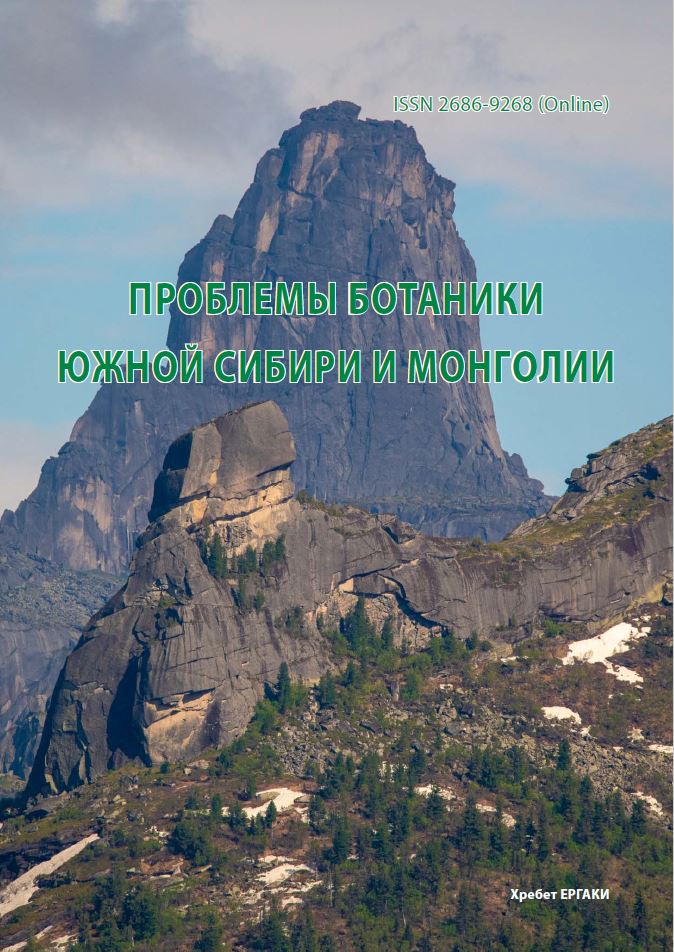The phenomenon of heterogeneity in the state of seed dormancy
УДК 58.084:581.543
Abstract
Developed as an adaptive strategy, the phenomenon of seed dormancy retained the ability to evolve and can change along with the changes in environmental conditions (temperature, humidity, light, availability of nutrients). Seed dormancy is the center of the so-called “thermal memory”, playing a key role in the acclimatization of plants to the seasonal climate. By saving information about the past temperature conditions of the species existence, the seeds manifest a high degree of heterogeneity in depth and type of dormancy, which varies depending on the location of the seed in the fruit and the fruit on the inflorescence, seed size, altitude and latitudinal areal of plant populations, weather conditions for seed maturation and preservation in soil. The high degree of plasticity of dormancy state requires different approaches to the study of this problem. In this regard, the article gives a number of recommendations for carrying out experiments and using special methods. One should take into account the areal of the species, the weather conditions for seed maturation and the periods of seed dry storage. Factors such as temperature and illumination should be applied in a differentiated way that permit to reveal the individual mechanisms of the initiation and removal of dormancy. The use of different methods -monitoring of seed germination, the culture of isolated embryos, cytoembryological study - makes it possible to assess the internal state of the seed and the localization of the mechanism of inhibition of post-development and germination of the embryo.
Downloads
Metrics
References
Бутузова О. Г. Особенности формирования семян у Pulsatilla vulgaris и Helleborus niger (Ranunculaceae) с до-развитием зародыша // Бот. журн., 2018. - Т. 103, № 3. - С. 313-330. DOI: 10.1134/S0006813618030031
Николаева М. Г. Покой семян и способы его преодоления // Онтогенез, 1983. - Т. 24, № 24. - С. 85-86.
Эрст А. А. Особенности прорастания семян и развития зародышей представителей семейства Ranunculaceae // Экосистемы, 2020. - Т. 23. - С. 100-110. DOI: 10.37279/2414-4738-2020-23-100-110
Baskin J. M., Baskin C. C. A classification system for seed dormancy // Seed Science Research, 2004. - Vol. 14. -P. 1-16. DOI: 10.1079/SSR2003150
Brink H., Haaland T. R., Opedal 0. H. Seasonality and competition select for variable germination behavior in perennials // bioRxiv preprint, 2022. DOI: 10.1101/2022.01.13.476161
Butuzova O., Torshilova A., Andronova E. Seed dormancy in Cardiocrinum cordatum var. glehnii (Liliaceae) and ways of its overcoming // Int. J. Plant Repr. Biol., 2019. - Vol. 11, № 1. - P. 51-57. DOI: 10.14787/ijprb.2019 11.1
Chamorro D., Luna B., Moreno J. M. Local climate controls among-population variation in germination patterns in two Erica species across Western Iberia // Seed Sci. Res., 2018. - Vol. 28. - P. 112-122. DOI: 10.1017/S0960258518000041
Fernandez-Pascual E., Mattana E., Pritchard H. W. Seeds of future past: climate change and the thermal memory of plant reproductive traits // Biological Reviews, 2019. - Vol. 94, № 2. - P. 439-456. DOI: 10.1111/brVol.12461
Finkelstein R., Reeves W., Ariizumi T., Steber C. Molecular aspects of seed dormancy // Annu. ReVol. Plant Biol.,2008. - Vol. 59. - P. 387-415. DOI: 10.1146/annureVol.arplant.59.032607.092740
Gosling P. G., Shelagh A., McCartan, Peace A. J. Seed dormancy and germination characteristics of common alder (Alnus glutinosa L.) indicate some potential to adapt to climate change in Britain // Forestry: Inter. J. Forest Research, 2009. - Vol. 82, № 5. - P. 573-582. DOI: 10.1093/forestry/cpp024
Gremer J. R., Chiono A., Suglia E., Bontrager M., Okafor L., Schmitt J. Variation in the seasonal germination niche across an elevational gradient: the role of germination cueing in current and future climates // Amer. J. Bot., 2020. - Vol. 107, № 2. - P. 350-363. DOI: 10.1002/ajb2.1425
Hawkins T. S., Baskin C. C., Baskin J. M. Morphophysiological dormancy in seeds of three eastern North American Sanicula species Apiaceae subf. Saniculoideae): evolutionary implication for dormancy break // Plant Species Biology, 2010. - Vol. 25. - P. 103-113. DOI: 10.1111/j.1442-1984.2010.00273.x
Klupczynska E. A., Pawlowki T. A. Regulation of seed dormancy and germination mechanisms in a changing environment // Int. J. Mol. Sci., 2021. - Vol. 22. - P. 1357. DOI: 10.3390/ijms22031357
Martinez-Berdeja A., Stitzer M. C., Taylor M. A., Okada M., Ezcurra E., Runcie D. E., Schmitt J. Functional Variants of DOG1 Control Seed Chilling Responses and Variation in Seasonal Life-History Strategies in Arabidopsis thaliana // PNAS, 2020. - Vol. 117. - P. 2526-2534. DOI: 10.1073/pnas.1912451117
Mattana E., DawsM. I., Fenu G., Bacchetta G. Adaptation to habitat in Aquilegia species endemic to Sardinia (Italy): Seed dispersal, germination and persistence in the soil // Plant Biosystematics, 2012. - Vol. 146, № 2. - P. 374-383. DOI: 10.1080/11263504.2011.557097
Nomizy T., Niimi Y., Watanabe E. Embryo development and seed germination of Hepatica nobilis Schreber var. japonica as affected by temperature after sowing // Scientia Horticulturae, 2004. - Vol. 99. - P. 345-352. DOI: 10.1016/ S0304-4238(03)00115-8
Pelabon C., De Giorgi F., Opedal 0. H., Bolstad G. H., Raunsgard A., Armbruster W. S. Is there more to within-plant variation in seed size than developmental noise? // Evol. Biol., 2021. - Vol. 48. - P. 366-377. DOI: 10.1007/s11692-021-09544-y. Springer US
Wang W. Q., Song S. Q., Li S. H., Gan Y. Y., Wu J. H., Cheng H. Y. Seed dormancy and germination in Vitis amurensis and its variation // Seed Science Research, 2011. - Vol. 21. - P. 255-265. DOI: 10.1017/S0960258511000225



